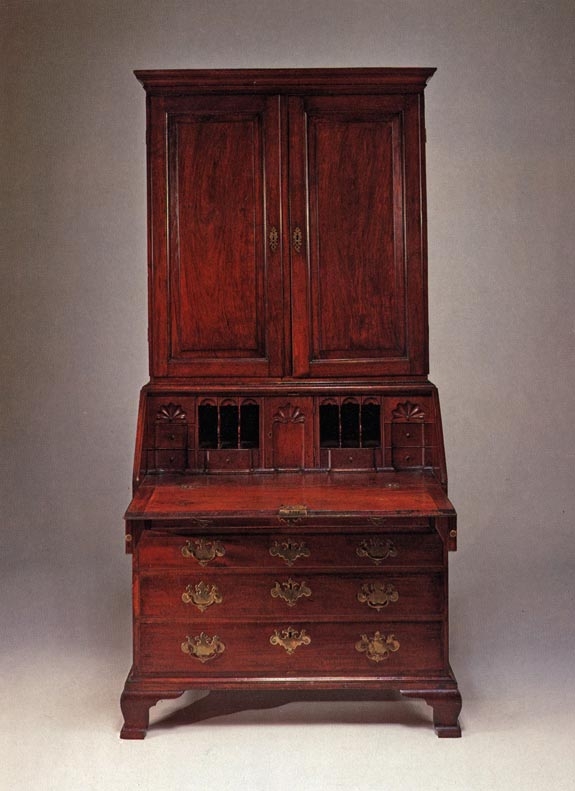NEW HAVEN, CT – For much of the past century, antiquarians have associated the former colony of Rhode Island with a group of supremely elegant block and shell-carved mahogany furniture made in the 18th century by members of two Newport Quaker clans, the Townsends and Goddards.
But as the new Rhode Island Furniture Archive (http://rifa.art.yale.edu) reveals, the state’s contribution is larger and more complex than previously supposed. To date, the Yale University Art Gallery team that created the site has identified more than 1,500 craftsmen working in the furniture and allied trades between 1636 and 1840.
The researchers have compiled more than 3,000 examples of case furniture, looking glasses and seating furniture. Clocks and tables will be added in the coming year.
Over a recent breakfast with Patricia E. Kane, the project’s director, and her husband, independent scholar W. Scott Braznell, I learned more about the origins of the project, which got underway in 2002, not long after Kane finished Colonial Massachusetts Silversmiths and Jewelry, the a comprehensive biographical dictionary published in 1998.
I also learned where the bodies are buried, so to speak, but more about that later.
“What we did for silver was a mammoth accomplishment, but the manuscript was out of date almost as soon as it went to the typesetters,” said Kane, who for Rhode Island furniture envisioned a versatile resource that could be updated continually.
Kane also wanted the archive to be of the broadest use to scholars, collectors and dealers, who can search the new site by a host of variables, including object name, maker, place of manufacture, date, owner and present location. The last variable alone should have the trade jumping to its feet.
As the Friends of American Arts Curator of American Decorative Arts at Yale University Art Gallery, Kane was fortunate to have the help of students, some of whom spent hours thumbing through vintage periodicals indentifying objects and noting their provenance. She benefitted from the support of individuals and organizations such as the Henry Luce Foundation, Inc., which funded a sabbatical that allowed her to spend a year researching public documents in Rhode Island record repositories.
The research, which has quintupled the number of known makers of Rhode Island furniture, is already bearing fruit. In January, Keno Auctions sold a mahogany desk and bookcase with a flat top and a fitted, shell-carved interior for $15,860 including premium. John Walton, the late Connecticut dealer, purchased the piece in 1984 at Sotheby’s, whose cataloguers discovered the signature of Daniel Spencer (1741-1801) inscribed on an interior drawer.
Thanks to Kane and her associates, we now know that Spencer and his brother, Thomas, were born in East Greenwich, R.I., to the older sister of cabinetmaker John Goddard (1724-1785) and that the family moved to Newport, where the brothers almost certainly apprenticed as cabinetmakers. The top board of the desk section is made of mahogany, a feature that is unusual enough to raise eyebrows had the archivists not also linked three secretary bookcases made around 1790 with similar mahogany tops to Ichabod Cole of Warren, R.I. Remarkably, two other Goddard nephews working as cabinetmakers, the brothers Ebenezer Allen, Jr. (1755-1793) and Cornelius Allen (1767-1835), have also come to light.
Building a digitized archive from scratch presents many challenges, from singling out craftsmen not clearly identified in historical records as cabinetmakers to weighting values properly so that the search produces optimal results. Databases need ongoing maintenance and a protocol for keeping them current.
That is where you, dear reader, come in. A link provided on the Rhode Island Furniture Archive’s home page allows users to submit discoveries of their own. No doubt Yale University Art Gallery would welcome monetary contributions, as well.
So, where are the “ bodies” buried? In the ground, as it turns out.
“Some indigents were buried in coffins made by John Townsend (1732-1809), who was paid by the town of Newport. I doubt if those coffins had blocks and shells or were made of mahogany,” W. Scott Braznell says with a smile.
Wednesday, 23 March 2011 01:11
Beyond Blocks and Shells in Rhode Island
 Nearly a decade in the making, the Rhode Island Furniture Archive is a searchable database of more than 3,000 documented objects and 1,500 makers. Sold at Keno Auctions in January for $15,860, this signed desk and bookcase is by Daniel Spencer, recently identified as one of four nephews of master craftsman John Goddard who worked as cabinetmakers.
Nearly a decade in the making, the Rhode Island Furniture Archive is a searchable database of more than 3,000 documented objects and 1,500 makers. Sold at Keno Auctions in January for $15,860, this signed desk and bookcase is by Daniel Spencer, recently identified as one of four nephews of master craftsman John Goddard who worked as cabinetmakers.
Additional Info
- Category: News